Introduction
Soil is a carbon sink, and soil organic matter (SOM) is an effective indicator of its quality. SOM affects metal complexation, which is a carbon source for soil microbes, and, consequently, nutrient cycling. SOM also affects aggregation and water infiltration (Pessoa et al., 2012). In general, total organic carbon (TOC) is used to evaluate the effects of soil tillage on SOM, but it cannot detect differences among practices, partly because 85% of TOC is composed of humic substances, such as humidified macromolecules, that are resistant to microbial mineralization, and partly because of natural soil variability (Silva and Mendonça, 2007; Geraei, Hojati, Landi, and Cano, 2016).
SOM is composed of a heterogeneous mixture of labile and recalcitrant compounds. In addition to resistant fractions that have cycling rates that are measured in years, it is also composed by labile fractions such as microbial biomass, light organic matter, and soluble carbon, which can be rapidly mineralized and change SOM dynamics (Geraei et al., 2016). In pastures of the Brazilian Amazon, it is common to use fire to weed control to stimulate grass regrowth, because ash increases soil fertility. However, the benefits of this process are short-lived (Araújo, Ker, Mendonça, Silva, and Oliveira., 2011; Santana, Dick, Tomazi, Bayer and Jacques, 2013) because weed control can also increase soil exposure. In the absence of a productive pasture, weeds are an alternative to inefficient management because they keep the soil covered, increase carbon levels and the cation exchange capacity, and protect the soil against erosion (Araújo-Jr., Guimaráes, Dias-Jr., Alcántara, and Mendes 2011).
In pastoral systems, the topsoil is sensitive to management changes, particularly due surface compaction caused by heavy animals in extensive systems, and to soil microbial activity and plant material contributions that affect organic matter compartments with respect to soil depth (Boeni et al., 2014). This study aimed to evaluate the effects of burning and manual weed cutting on vegetation cover and different compartments of organic matter in the soil surface layer of Urochloa brizantha pastures.
Material and methods
Site description
The study was conducted in Itupiranga county (05 ° 08 ‘ 20 “ S and 49 ° 19 ‘ 25 W), Pará state, which is part of the Brazilian Amazon. The soil is Latossolo Vermelho-Amarelo (Embrapa, 2009). The regional climate is Am in transition to Aw, has an average annual temperature of 26.35 °C, and has a dry season between May and October and a wet season between November and April (Koppen and Geiger, 1954) (Figure 1).
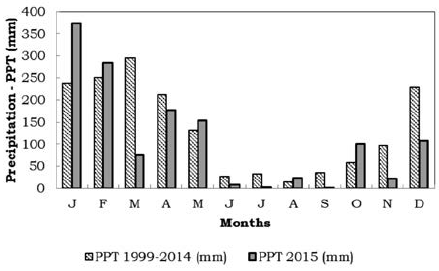
Figure 1 Average monthly precipitation (1999-2014 and 2015) in Itupiranga county, Pará state, Brazil.
Five pastures plot were evaluated in two contiguous farms (A and B), as well as a native forest fragment between them. Part of the native forest was slashed and burned for pasture in 1993 and was seeded with Urochloa brizantha cv. Marandu. The pastures never received any type of improvement or fertilizer and were only subjected to slash-and-burn agriculture and weed cutting (Table 1).
Table 1 Management applied in five areas of Urochloa brizantha pasture in Itupiranga county, Pará state, Brazil.
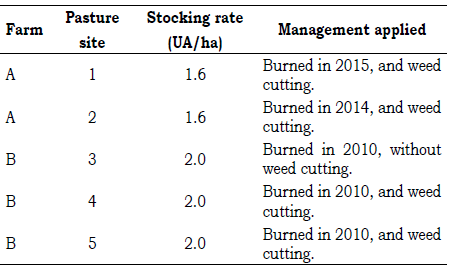
Data were collected in 2015 during the dry season (July). Vegetation cover (U. brizantha, weeds, and bare soil, %) was estimated using a quadrat (Martha Jr. et al., 1999), which consisted of a 2.0 m2 wooden square that contained a checkered mesh of string with 80 small squares. Ten samples were recorded in each pasture. Weeds were considered any species other than U. brizantha, including Eupatorium sp., Cenchrus sp., Cynodon sp., and Crotalaria sp.
Soil sampling and analysis
Soil samples were collected from 0 - 5 cm below the soil surface. Four composite samples (obtained from three simple samples) were taken in each area. The samples were stored at 4 °C until analysis. In addition to the pasture, soil samples were also collected from a natural forest area as a reference.
In the laboratory, roots were manually removed from the soil samples before they were passed through a 2 mm sieve. Cumulative soil respiration was determined based on the levels of CO2-C that could be obtained from 50 g of soil in 30 ml of NaOH (0.5 mol L-1) over 30 days. Microbial biomass carbon (MBC) was determined by the irradiation and extraction method, using 20 g of soil and 80 mL of a K2SO4 solution (0.5 mol L-1). Light organic matter (LOM) levels in water were determined by flotation in water; after dispersing 50 g of soil in 100 ml of NaOH solution (0.1 mol L-1), the supernatant was passed through a 0.25 mm sieve. TOC levels were determined by wet oxidation. Water-soluble carbon (WSC) was extracted from 10 g of soil with 20 ml of distilled water, and its levels were determined by colorimetry at a wavelength of 495 nm. The ability of soil microorganisms to immobilize carbon was estimated using the MBC:TOC ratio (Mendonça and Matos, 2017).
Statistical analysis
The normality of the data was checked (Shapiro and Wilk, 1965) before a cluster analysis was conducted based on the vegetation cover data, in order to identify groups in terms of pasture similarity. These data were subjected to an analysis of variance (Anova) and a post- hoc test (Tukey, P < 0.05). The pasture SOM data were combined based on the groups obtained by the cluster analysis, and compared with the reference area (forest) by Anova and a post-hoc test (Tukey, P < 0.05). A principal component analysis (PCA) was performed to analyze relationships among the vegetation cover variables and pasture SOM. All of the analyses were performed using R, version 3.0.1 (R Core Team, 2013).
Results
Descriptive statistics of the vegetation cover variables are presented in Table 2. The highest percentage of U. brizantha cover was in pastures plot 4 (90.6%) and 5 (89.4%), the highest percentage of bare soil was in pasture plot 1 (40.4%), and the highest percentage of weed cover was in pasture plot 3 (53.4%).
The vegetation cover variables were subjected to a cluster analysis based on Euclidean distances by the complete method. It was identified three groups among the pastures plots evaluated (Figure 2): Group 1 consisted of pastures plots 1 and 2 (Farm A), Group 2 contained pastures plots 4 and 5 (Farm B), and Group 3 only contained pasture plot 3 (Farm B).
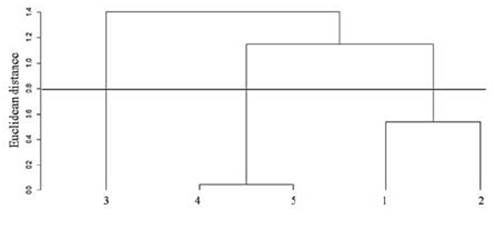
Figure 2 Cluster analysis of five Urochloa brizantha pastures in Itupiranga county, Pará state, Brazil.
Table 2 Averages and standard deviations of vegetation cover variables in five pastures in Itupiranga county, Pará state, Brazil
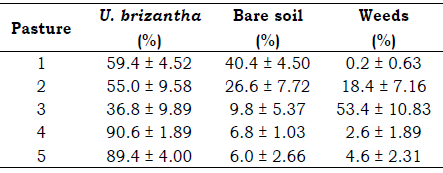
The vegetation cover data were combined based on their clustered groups, and subjected to an Anova (Table 3). Group 2 had the highest average U. brizantha cover (90%), followed by Groups 1 (57.2%) and 3 (36.8%). Group 1 had the highest average percentage of bare soil (33.5%), followed by Groups 2 (6.4%) and 3 (9.8%). Group 3 had the highest average weed cover (53.4%), followed by Groups 1 (9.3%) and 2 (3.6%). As expected, the forest had the highest average TOC levels (36.52 g/kg), followed by Groups 2 (26.18 g/kg), 1 (25.73 g/kg), and 3 (22.63 g/kg) (Table 4). Group 3 had the highest average cumulative soil respiration (2.6 g/kg), followed by the forest (1.19 g/kg) and Groups 1 (0.64 g/kg) and 2 (0.68 g/kg). MBC did not significantly differ between the groups and the forest. The forest and Group 3 had the highest MBC:TOC values (0.0138 and 0.0156, respectively), followed by Groups 2 (0.0106) and 1 (0.0084). LOM levels did not significantly differ between the groups and the forest. The forest had the highest WSC value (21.08 g/kg), followed by Groups 2 (20.44 g/kg), (10.92 g/kg), and 1 (2.28 g/kg).
Table 3 Averages (%) of vegetation cover variables in three groups of Urochloa brizantha pasture in Itupiranga county, Pará state, Brazil.

*Different uppercase letters in a column indicate a statistically significant difference (p<0.05) between the groups according to the Tukey test. *Coefficient of variation
Table 4 Averages (%) of soil organic matter variables of three groups of Urochloa brizantha pasture and native forest in Itupiranga county, Pará state, Brazil.

*Different uppercase letters in a column indicate a statistically significant difference (p<0.05) between the groups according to the Tukey test. TOC: total organic carbon (g/kg); AR: cumulative soil respiration (mg/kg); MBC: microbial biomass carbon (g/kg); MBC:TOC: ratio between MBC and TOC; LOM: light organic matter (g/kg); WSC: water-soluble carbon (mg/kg). *Coefficient of variation.
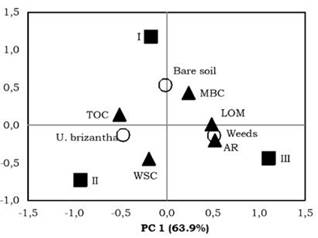
Figure 3 Principal component analysis of vegetation cover and soil organic matter in Urochloa brizantha pastures in Itupiranga county, Pará state, Brazil. TOC: total organic carbon; AR: cumulative soil respiration; MBC: microbial biomass carbon; LOM: light organic matter; WSC: water-soluble carbon.
The PC A results are presented in Figure 3, which do not include data related to the forest because we did not collect vegetation cover data for that area, and the MBC:TOC ratio was not included in this analysis to avoid multicollinearity (Hair, Anderson, Tatham, and Black, 2005). Principal component 1 (PC 1) explained 63.9% of the variability, and principal component 2 (PC 2) explained 36.1%. Group 1 was associated with bare soil, Group 2 with U. brizantha cover, TOC, and WSC, and Group 3 with weed cover, soil respiration, and LOM.
Discussion
Group 1 had the highest average percentage of bare soil, probably because burning between 2014 and 2015 affected vegetation cover and caused an increase in bare soil. Burning is a very common practice among Brazilian farmers, because theoretically it increases soil fertility by adding nutrients from ash. However, this benefit is temporary, because the soils are exposed to leaching by rainfall, leading to low soil fertility and increase aluminum saturation, which affect plant growth (Heringer & Jacques, 2002; Santana et al., 2013).
The absence of fire, and the practice of weed control, may have caused the high percentage of U. brizantha cover in Group 2. Forage management without an excessive use of fire can benefit vegetation growth. Plant shoots protect the soil surface, preventing moisture loss (Heringer and Jacques, 2002). Group 3 (that only contained Pasture plot 3) had the highest average weed cover, probably because it received no weed control.
Group 2, which was managed without burning, had the highest carbon content. Pastures that receive appropriate management have great potential for storing carbon, because they have a high root biomass, particularly of fine roots, and more accelerated root system renewal. So, it could have large carbon stocks in the soil surface (0-10 cm deep) under pasture (~50 mg ha-1 carbon) than under native forest (~40 mg ha-1 carbon) (Monroe, Gama-Rodrigues, Gama- Rodrigues, and Marques, 2016).
Burning and weed control in Groups 1 and 2 negatively affected microbial activity. CO2 emission quantification evaluates the impacts of anthropogenic changes on natural ecosystems by measuring changes in microbial activity. Abraham and Joseph (2015) evaluated areas of pasture subjected to two management systems: with and without manual weed removal. The authors found a higher CO2 efflux and greater plant biomass in areas without weed control than in areas with weed control. This was attributed, by the authors, to greater plant diversity resulting in a higher quality of organic matter, leading to increased mineralization and higher CO2 emissions during microbial respiration.
Although there was no significant difference in MBC between the groups, the forest and Group 2 had significantly higher MBC:TOC values than the other groups. The MBC:TOC ratio indicates SOM quality; low values of this index, as found in the burned areas, indicate low SOM quality, and, consequently, low carbon immobilization efficiency by soil microorganisms, with higher energy spent (Bini, Santos, Bouillet, Gongalves, and Cardoso, 2013). In the forest and Group 3, the greater diversity and quality of litter may have favored microbial metabolism, so more carbon was fixed with little energy expenditure, as indicated by the high MBC:TOC values. There was no significant difference in LOM levels between the groups and the forest. Araújo et al. (2011) evaluated LOM levels in U. brizantha pastures in two locations in eastern Acre state, Brazil, and reported contradictory results. In the first location, two pastures, a three-year-old pasture and a ten-year-old pasture, had a lower (84.20 g kg-1) and a higher value (146 g kg-1), respectively, of LOM than native forest (143.9 g kg-1). In the second location, a 20-year-old pasture had a lower (129.9 g kg-1) LOM level than native forest (263.5 g kg-1). Therefore, contrary to expectations, grass does not always lead to a greater amount of LOM in U. brizantha pastures (Lima et al., 2011).
Burning decreased WSC levels. WSC consists of open-chain carbon compounds, and has a close relationship with soil microorganisms (Pessoa et al., 2012). In forest environments, this type of carbon occurs manly via litter deposited on the soil, while in pastoral environments, it occurs manly via root exudates (Spohn, Klaus, Wanek, and Richter, 2016). Therefore, pasture management that only involved weed cutting control (Group 2) proved to be the most effective in maintaining the most labile forms of carbon in the soil, because it did not affect the grass.
Contrary to what we observed in Group 1, which had the highest average percentage of bare soil, the presence of grass in Group 2 may have contributed to its high TOC and WSC values. High shoot and root biomasses contribute to soil organic carbon levels, and most fine roots are in the first 15 cm of soil and can contribute to labile forms of carbon, such as organic acids (Geraei et al., 2016). Group 3 had the highest average weed cover, and the greater diversity of plants may have resulted in the deposition of high-quality LOM, leading to increases in organic matter mineralization and cumulative soil respiration.
Conclusions
Pastures were grouped into three groups according to the management they received. A high percentage of bare soil, U. brizantha cover, and weed cover characterized Groups 1, 2 and 3, respectively. U. brizantha cover (Group 2) resulted in high TOC and WSC levels, while the greater diversity of species in Group 3 (weed cover) resulted in the diversification of aboveground material and greater microbial activity.














